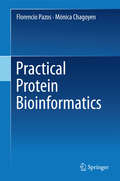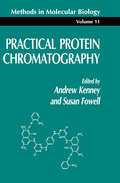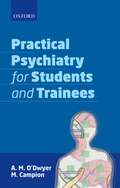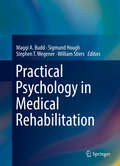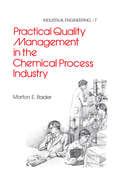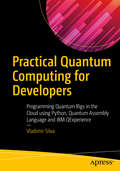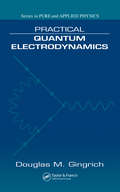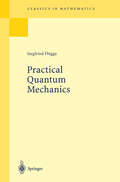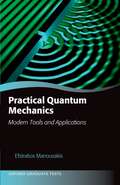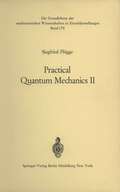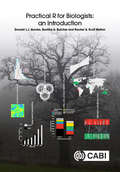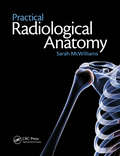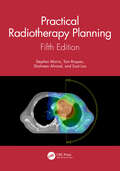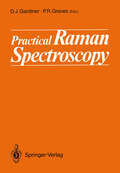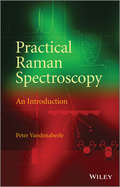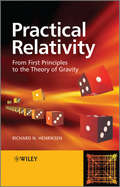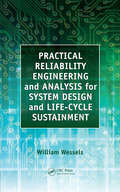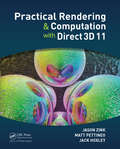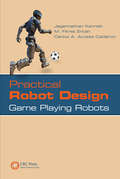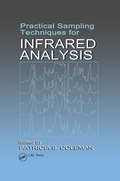- Table View
- List View
Practical Protein Bioinformatics
by Florencio Pazos Mónica ChagoyenThis book describes more than 60 web-accessible computational tools for protein analysis and is totally practical, with detailed explanations on how to use these tools and interpret their results and minimal mentions to their theoretical basis (only when that is required for making a better use of them). It covers a wide range of tools for dealing with different aspects of proteins, from their sequences, to their three-dimensional structures, and the biological networks they are immersed in. The selection of tools is based on the experience of the authors that lead a protein bioinformatics facility in a large research centre, with the additional constraint that the tools should be accessible through standard web browsers without requiring the local installation of specific software, command-line tools, etc.The web tools covered include those aimed to retrieve protein information, look for similar proteins, generate pair-wise and multiple sequence alignments of protein sequences, work with protein domains and motifs, study the phylogeny of a family of proteins, retrieve, manipulate and visualize protein three-dimensional structures, predict protein structural features as well as whole three-dimensional structures, extract biological information from protein structures, summarize large protein sets, study protein interaction and metabolic networks, etc.The book is associated to a dynamic web site that will reflect changes in the web addresses of the tools, updates of these, etc. It also contains QR codes that can be scanned with any device to direct its browser to the tool web site.This monograph will be most valuable for researchers in experimental labs without specific knowledge on bioinformatics or computing.
Practical Psychiatry for Students and Trainees
by A. M. O'Dwyer M. CampionAre you unsure what to ask in a psychiatric clinical interview and how to ask it? Are you a medical student or trainee doctor that needs a fast hands-on guide to psychiatry? This handbook sets out clinical interviewing skills and clinical tips so you can deliver essential psychiatric care with confidence. Almost all medical graduates will encounter patients with mental health issues in general medical and surgical settings. Practical Psychiatry for Students and Trainees provides the foundational skillset you need for interviewing, assessing, and initially managing a patient with mental health issues. Organised into 19 short chapters, this resource leads you logically from how to interview a patient, to the psychiatric conditions likely to be encountered and their treatments. Packed with practical tips and clinical cases from a variety of medical professionals, this text delivers clear guidance and skills. Written by an experienced psychiatrist and a psychiatric trainee, this book provides you with the core knowledge and skills needed to deliver self-assured care to patients with mental health needs.
Practical Psychiatry for Students and Trainees
by A. M. O'Dwyer M. CampionAre you unsure what to ask in a psychiatric clinical interview and how to ask it? Are you a medical student or trainee doctor that needs a fast hands-on guide to psychiatry? This handbook sets out clinical interviewing skills and clinical tips so you can deliver essential psychiatric care with confidence. Almost all medical graduates will encounter patients with mental health issues in general medical and surgical settings. Practical Psychiatry for Students and Trainees provides the foundational skillset you need for interviewing, assessing, and initially managing a patient with mental health issues. Organised into 19 short chapters, this resource leads you logically from how to interview a patient, to the psychiatric conditions likely to be encountered and their treatments. Packed with practical tips and clinical cases from a variety of medical professionals, this text delivers clear guidance and skills. Written by an experienced psychiatrist and a psychiatric trainee, this book provides you with the core knowledge and skills needed to deliver self-assured care to patients with mental health needs.
Practical Psychology in Medical Rehabilitation
by Maggi A. Budd Sigmund Hough Stephen T. Wegener William StiersThis easy-access guide summarizes the dynamic specialty of rehabilitation psychology, focusing on real-world practice in the medical setting. It begins by placing readers at the frontlines of practice with a solid foundation for gathering information and communicating effectively with patients, families, and staff. The book’s topics run a wide gamut of patient conditions (neurological, musculoskeletal, cardiovascular), related problems (sleep and fatigue issues, depression) and practitioner responses (encouraging coping and compliance, pediatric and geriatric considerations). Models of disability and adaptation, review of competency concerns, and guidelines for group and individual therapy offer evidence-based insights for helping patients manage their health conditions, benefit from rehabilitation interventions, and prepare for their post-rehabilitation lives and activities. Coverage spotlights these core areas: ·Basics and biopsychosocial practicalities, from behavioral medicine and psychopharmacology to ethical and forensic issues. ·Populations, problems, and procedures, including stroke, TBI, substance abuse, transplants, and severe mental illness. ·Assessment and practical interventions such as pain, anxiety, cognitive functioning, and more. ·Consultation, advocacy, and interdisciplinary teams. ·Practice management, administration, and professional self-care. ·Research, technology, and program evaluation. Practical Psychology in Medical Rehabilitation is an essential professional development tool for novice (and a refresher for veteran) psychologists and neuropsychologists, as well as rehabilitation physicians, nurses, therapists, psychiatrists, and social workers. It presents in depth both the hallmarks of the specialty and the nuts and bolts of being a valuable team player in a medical setting.
Practical Quality Management in the Chemical Process Industry
by Morton E. BaderThis book is a manual for designing and operating a basic quality management program; a practical discussion of what is needed and how to fulfill those needs on a practical basis. It will be helpful to chemical engineers, plant laboratory managers and those interested in quality management.
Practical Quality Management in the Chemical Process Industry
by Morton E. BaderThis book is a manual for designing and operating a basic quality management program; a practical discussion of what is needed and how to fulfill those needs on a practical basis. It will be helpful to chemical engineers, plant laboratory managers and those interested in quality management.
Practical Quantum Computing for Developers: Programming Quantum Rigs In The Cloud Using Python, Quantum Assembly Language And Ibm Qexperience
by Vladimir SilvaWrite algorithms and program in the new field of quantum computing. This book covers major topics such as the physical components of a quantum computer: qubits, entanglement, logic gates, circuits, and how they differ from a traditional computer. Also, Practical Quantum Computing for Developers discusses quantum computing in the cloud using IBM Q Experience including: the composer, quantum scores, experiments, circuits, simulators, real quantum devices, and more. You’ll be able to run experiments in the cloud on a real quantum device.Furthermore, this book shows you how to do quantum programming using the QISKit (Quantum Information Software Kit), Python SDK, and other APIs such as QASM (Quantum Assembly). You’ll learn to write code using these languages and execute it against simulators (local or remote) or a real quantum computer provided by IBM’s Q Experience. Finally, you’ll learn the current quantum algorithms for entanglement, random number generation, linear search, integer factorization, and others. You’ll peak inside the inner workings of the Bell states for entanglement, Grover’s algorithm for linear search, Shor’s algorithm for integer factorization, and other algorithms in the fields of optimization, and more.Along the way you’ll also cover game theory with the Magic Square, an example of quantum pseudo-telepathy where parties sharing entangled states can be observed to have some kind of communication between them. In this game Alice and Bob play against a referee. Quantum mechanics allows Alice and Bob to always win!By the end of this book, you will understand how this emerging technology provides massive parallelism and significant computational speedups over classical computers, and will be prepared to program quantum computers which are expected to replace traditional computers in the data center.What You Will LearnUse the Q Experience Composer, the first-of-its-kind web console to create visual programs/experiments and submit them to a quantum simulator or real device on the cloudRun programs remotely using the Q Experience REST API Write algorithms that provide superior performance over their classical counterpartsBuild a Node.js REST client for authenticating, listing remote devices, querying information about quantum processors, and listing or running experiments remotely in the cloudCreate a quantum number generator: The quintessential coin flip with a quantum twistDiscover quantum teleportation: This algorithm demonstrates how the exact state of a qubit (quantum information) can be transmitted from one location to another, with the help of classical communication and quantum entanglement between the sender and receiverPeek into single qubit operations with the classic game of Battleships with a quantum twistHandle the counterfeit coin problem: a classic puzzle that consists of finding a counterfeit coin in a beam balance among eight coins in only two turnsWho This Book Is ForDevelopers and programmers interested in this new field of computing.
Practical Quantum Electrodynamics (Pure And Applied Physics Ser.)
by Douglas M. GingrichTaking a heuristic approach to relativistic quantum mechanics, Practical Quantum Electrodynamics provides a complete introduction to the theory, methodologies, and calculations used for explaining the physical interaction of charged particles. This book combines the principles of relativity and quantum theory necessary for performing the ca
Practical Quantum Mechanics (Classics in Mathematics)
by Siegfried FlüggeThis work was first published in 1947 in German under the title "Re chenmethoden der Quantentheorie". It was meant to serve a double purpose: to help both, the student when first confronted with quantum mechanics and the experimental scientist, who has never before used it as a tool, to learn how to apply the general theory to practical problems of atomic physics. Since that early date, many excellent books have been written introducing into the general framework of the theory and thus indispensable to a deeper understanding. It seems, however, that the more practical side has been somewhat neglected, except, of course, for the flood of special monographs going into broad detail on rather restricted topics. In other words, an all-round introduction to the practical use of quantum mechanics seems, so far, not to exist and may still be helpful. It was in the hope of filling this gap that the author has fallen in with the publishers' wish to bring the earlier German editions up to date and to make the work more useful to the worldwide community of science students and scientists by writing the new edition in English. From the beginning there could be no doubt that the work had to be much enlarged. New approximation methods and other developments, especially in the field of scattering, had to be added. It seemed necessary to include relativistic quantum mechanics and to offer, at least, a glimpse of radiation theory as an example of wave field quantization.
Practical Quantum Mechanics: Modern Tools and Applications (Oxford Graduate Texts)
by Efstratios ManousakisQuantum mechanics forms the foundation of all modern physics, including atomic, nuclear, and molecular physics, the physics of the elementary particles, condensed matter physics. Modern astrophysics also relies heavily on quantum mechanics. Quantum theory is needed to understand the basis for new materials, new devices, the nature of light coming from stars, the laws which govern the atomic nucleus, and the physics of biological systems. As a result the subject of this book is a required course for most physics graduate students. While there are many books on the subject, this book targets specifically graduate students and it is written with modern advances in various fields in mind. Many examples treated in the various chapters as well as the emphasis of the presentation in the book are designed from the perspective of such problems. For example, the book begins by putting the Schrödinger equation on a spatial discrete lattice and the continuum limit is also discussed, inspired by Hamiltonian lattice gauge theories. The latter and advances in quantum simulations motivated the inclusion of the path integral formulation. This formulation is applied to the imaginary-time evolution operator to project the exact ground state of the harmonic oscillator as is done in quantum simulations. As an example of how to take advantage of symmetry in quantum mechanics, one-dimensional periodic potentials are discussed, inspired by condensed matter physics. Atoms and molecules are discussed within mean-field like treatment (Hartree-Fock) and how to go beyond it. Motivated by the recent intense activity in condensed matter and atomic physics to study the Hubbard model, the electron correlations in the hydrogen molecule are taken into account by solving the two-site Hubbard model analytically. Using the canonical Hamiltonian quantization of quantum electrodynamics, the photons emerge as the quanta of the normal modes, in the same way as the phonons emerge in the treatment of the normal modes of the coupled array of atoms. This is used later to treat the interaction of radiation with atomic matter.
Practical Quantum Mechanics II (Grundlehren der mathematischen Wissenschaften #178)
by Siegfried FlüggePractical R for Biologists: An Introduction
by Donald Quicke Buntika A Butcher Rachel Kruft WeltonR is a freely available, open-source statistical programming environment which provides powerful statistical analysis tools and graphics outputs. R is now used by a very wide range of people; biologists (the primary audience of this book), but also all other scientists and engineers, economists, market researchers and medical professionals. R users with expertise are constantly adding new associated packages, and the range already available is immense. This text works through a set of studies that collectively represent almost all the R operations that biology students need in order to analyse their own data. The material is designed to serve students from first year undergraduates through to those beginning post graduate levels. Chapters are organized around topics such as graphing, classical statistical tests, statistical modelling, mapping, and text parsing. Examples are based on real scientific studies, and each one covers the use of more R functions than those simply necessary to get a p-value or plot. The book walks the reader through the data analysis process, starting with very simple plots, and continuing through more complex analyses and programming. It shows how to deal with issues such as error messages that can be confronting for beginners, in order to set students up for a successful scientific career using R. Collectively the authors have a vast amount of teaching experience which they apply here to make the passage into R programming as gentle and easy as possible, whilst guiding the reader to tackle quite complicated programming.
Practical Radiological Anatomy
by Sarah McWilliamsPractical Radiological Anatomy is an illustrated and concise revision textbook for radiology trainees learning to interpret all modes of imaging.Features:Uses a convenient format arranged by body systemContains high-quality images demonstrating the key features of basic anatomySupplies both conventional imaging and cross-sectional CT and MRI anatom
Practical Radiotherapy Planning: Fifth Edition
by Stephen Morris Tom Roques Shahreen Ahmad Suat LooGood and effective treatment in radiotherapy requires careful consideration of the complex variables involved as well as critical assessment of the techniques. This new edition of an established classic takes into account advances in imaging and treatment delivery and reflects the current state of the art in the practice of radiotherapy, emphasizing the underlying principles of treatment that can be applied for conventional, conformal, and novel treatments.
Practical Radiotherapy Planning: Fifth Edition
by Stephen Morris Tom Roques Shahreen Ahmad Suat LooGood and effective treatment in radiotherapy requires careful consideration of the complex variables involved as well as critical assessment of the techniques. This new edition of an established classic takes into account advances in imaging and treatment delivery and reflects the current state of the art in the practice of radiotherapy, emphasizing the underlying principles of treatment that can be applied for conventional, conformal, and novel treatments.
Practical Raman Spectroscopy
by Heather J. Bowley Derek J. Gardiner Don L. Gerrard Pierre R. Graves John D. Louden George TurrellThis volume sets out to draw together the essential expertise which will provide a technical guide to the practice of Raman spectroscopy. The text deals exc1usively with spontaneous Raman spectroscopy and inc1udes some aspects of Resonance Raman spectroscopy. Chapter I sets out the essential theoretical framework using a simple c1assical approach and deals with the rudiments of polarizability. Many of these theoretical points are further developed in Chap. 2 where the scattering and polarization consequences of various sampling geometries and collection optics, on gaseous, liquid, single crystal and thin film methods are detailed. The relative advantages and disadvantages of the wide variety of hardware now available to the Raman spectroscopist are discussed in Chap. 3. Important calibration data is pr. esented in Chap. 4 along with an account of datä analysis techniques, inc1uding signal enhancement methods. Chapter 5 describes some of the techniques and cell designs that have been successfully used to study sampies under extreme conditions and Chap. 6 deals with the rapidly growing technique of Raman microscopy, providing a wide range of application examples and experimental advice. We recognise the difficulty in covering all aspects of Raman spectroscopy in a single volume and a section on further reading, representing what we feel are amongst the more informative references, at the time of publication, is provided for additional detail. Our hope is that Practical Raman Spectroscopy will help to provide a source of on-hand technical support and data for the practising Raman spectroscopist in the laboratory.
Practical Raman Spectroscopy: An Introduction (Analytical Techniques In The Sciences (ants) * Ser.)
by Peter VandenabeeleThis text offers an open-learning approach to Raman spectroscopy providing detail on instrumentation, applications and discussions questions throughout the book. It provides a valuable guide to assist with teaching Raman spectroscopy which is gaining attention in (analytical) chemistry, and as a consequence, teaching programs have followed. Today, education in Raman spectroscopy is often limited to theoretical aspects (e.g. selection rules), but practical aspects are usually disregarded. With these course notes, the author hopes to fill this gap and include information about Raman instrumentation and how it is interpreted. Provides a user-friendly text that tackles the theoretical background, and offers everyday tips for common practice Raman instrumentation and practical aspects, which are sometimes overlooked, are covered Appropriate for students, and includes summaries, text boxes, illustrating the ideas with examples from research literature or providing background information or links with other courses Written with an open-learning approach, this book will be ideal for use as a self-study guide or as the basis of a taught course with discussion and self-assessment questions throughout the text Includes a comprehensive bibliography to guide the reader to more specialized texts and sources.
Practical Raman Spectroscopy: An Introduction
by Peter VandenabeeleThis text offers an open-learning approach to Raman spectroscopy providing detail on instrumentation, applications and discussions questions throughout the book. It provides a valuable guide to assist with teaching Raman spectroscopy which is gaining attention in (analytical) chemistry, and as a consequence, teaching programs have followed. Today, education in Raman spectroscopy is often limited to theoretical aspects (e.g. selection rules), but practical aspects are usually disregarded. With these course notes, the author hopes to fill this gap and include information about Raman instrumentation and how it is interpreted. Provides a user-friendly text that tackles the theoretical background, and offers everyday tips for common practice Raman instrumentation and practical aspects, which are sometimes overlooked, are covered Appropriate for students, and includes summaries, text boxes, illustrating the ideas with examples from research literature or providing background information or links with other courses Written with an open-learning approach, this book will be ideal for use as a self-study guide or as the basis of a taught course with discussion and self-assessment questions throughout the text Includes a comprehensive bibliography to guide the reader to more specialized texts and sources.
Practical Relativity: From First Principles to the Theory of Gravity
by Richard N. HenriksenThe book is intended to serve as lecture material for courses on relativity at undergraduate level. Although there has been much written on special relativity the present book will emphasize the real applications of relativity. In addition, it will be physically designed with the use of box summaries so as to allow easy access of practical results. The book will be composed of eight chapters. Chapter 1 will give an introduction to special relativity that is the world without gravity. Implications will be presented with emphasis on time dilation and the Doppler shift as practical considerations. In Chapter 2, the four-vector representation of events will be introduced. The bulk of this chapter will deal with flat space dynamics. This will require the generalization of Newton's first and second laws. Some important astronomical applications will be discussed in Chapter 3 and in Chapter 4 some engineering applications of special relativity such as atomic clocks will be presented. Chapter 5 will be dedicated to the thorny question of gravity. The physical motivation of the theory must be examined and the geometrical interpretation presented. Chapter 6 will present astronomical applications of relativistic gravity. These include the usual solar system tests; light bending, time delay, gravitational red-shift, precession of Keplerian orbits. Chapter 7 will be dedicated to relativistic cosmology. Many of the standard cosmological concepts will be introduced, being mathematically simple but conceptually subtle. The concluding chapter will be largely dedicated to the global positioning system as an engineering problem that requires both inertial and gravitational relativity. The large interferometers designed as gravitational wave telescopes will be discussed here.
Practical Relativity: From First Principles to the Theory of Gravity
by Richard N. HenriksenThe book is intended to serve as lecture material for courses on relativity at undergraduate level. Although there has been much written on special relativity the present book will emphasize the real applications of relativity. In addition, it will be physically designed with the use of box summaries so as to allow easy access of practical results. The book will be composed of eight chapters. Chapter 1 will give an introduction to special relativity that is the world without gravity. Implications will be presented with emphasis on time dilation and the Doppler shift as practical considerations. In Chapter 2, the four-vector representation of events will be introduced. The bulk of this chapter will deal with flat space dynamics. This will require the generalization of Newton's first and second laws. Some important astronomical applications will be discussed in Chapter 3 and in Chapter 4 some engineering applications of special relativity such as atomic clocks will be presented. Chapter 5 will be dedicated to the thorny question of gravity. The physical motivation of the theory must be examined and the geometrical interpretation presented. Chapter 6 will present astronomical applications of relativistic gravity. These include the usual solar system tests; light bending, time delay, gravitational red-shift, precession of Keplerian orbits. Chapter 7 will be dedicated to relativistic cosmology. Many of the standard cosmological concepts will be introduced, being mathematically simple but conceptually subtle. The concluding chapter will be largely dedicated to the global positioning system as an engineering problem that requires both inertial and gravitational relativity. The large interferometers designed as gravitational wave telescopes will be discussed here.
Practical Reliability Engineering and Analysis for System Design and Life-Cycle Sustainment
by William WesselsIn today's sophisticated world, reliability stands as the ultimate arbiter of quality. An understanding of reliability and the ultimate compromise of failure is essential for determining the value of most modern products and absolutely critical to others, large or small. Whether lives are dependent on the performance of a heat shield or a chip in a
Practical Rendering and Computation with Direct3D 11
by Jason Zink Matt Pettineo Jack HoxleyDirect3D 11 offers such a wealth of capabilities that users can sometimes get lost in the details of specific APIs and their implementation. While there is a great deal of low-level information available about how each API function should be used, there is little documentation that shows how best to leverage these capabilities. Written by active me
Practical Robot Design: Game Playing Robots
by Jagannathan KanniahDesigned for beginners, undergraduate students, and robotics enthusiasts, Practical Robot Design: Game Playing Robots is a comprehensive guide to the theory, design, and construction of game-playing robots. Drawing on years of robot building and teaching experience, the authors demonstrate the key steps of building a robot from beginning to end, wi
Practical Sampling Techniques for Infrared Analysis
by Patricia B. ColemanPractical Sampling Techniques for Infrared Analysis provides a single-source guide to sample handling for routine analysis in infrared spectroscopy using commercially available instrumentation and accessories. Following a review of infrared spectroscopic theory, chapters consider individual techniques such as transmission methodology (e.g., solution cells, KBr pellets), internal reflectance, diffuse reflectance, photoacoustic FT-IR, infrared microscopy, GC/FT-IR, and quantitative analysis. In addition, two chapters elaborate on both typical and unusual samples and problems encountered in industrial laboratories and the process by which a spectroscopist chooses the most effective technique. Various short courses on infrared analysis are also listed. Practical Sampling Techniques for Infrared Analysis will be an important guide for all professional analytical chemists and technicians.
